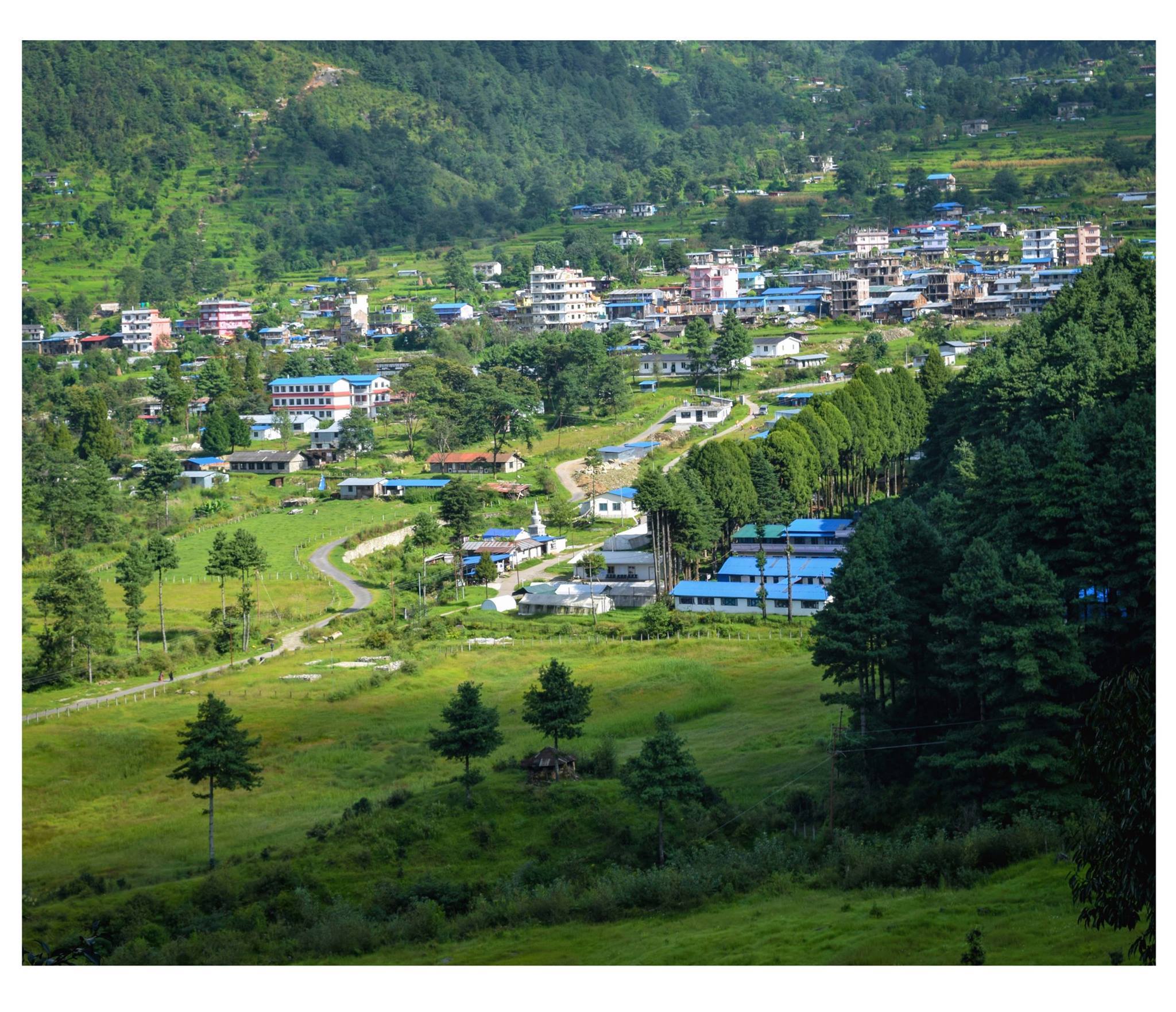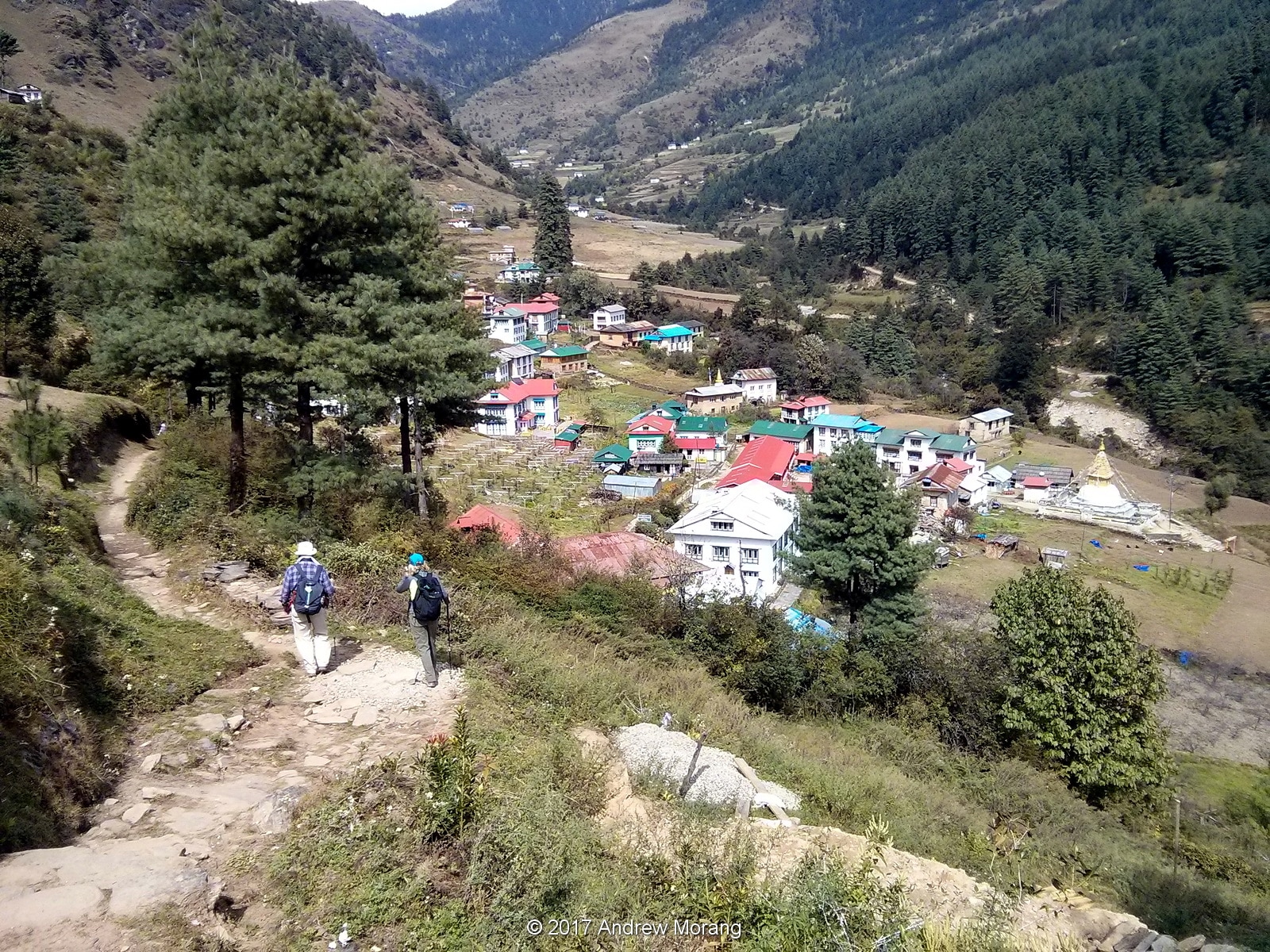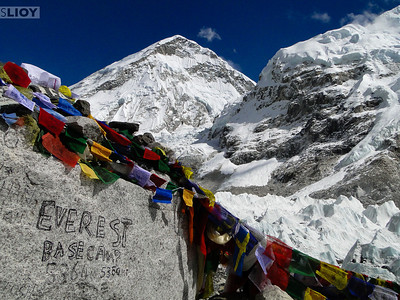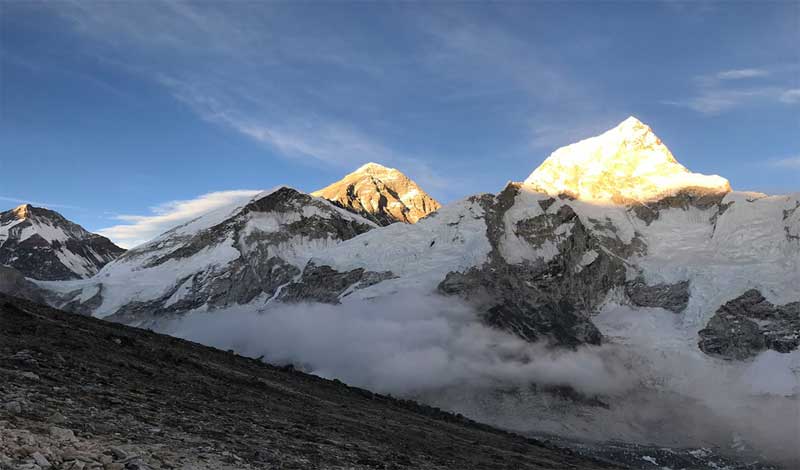Jiri to Everest Base Camp via Kalapatthar Trek
Trip Overview
Trip Highlight
- Follow the footprints of legendary Sir Edmund Hillary and Tenzing Norgay Sherpa
- Enjoy the authentic local foods and local lifestyle from the very beginning of your trek
- Discover the whole valley of the Everest region spending at the pastures, yak farms, and glaciers
- Enjoy the sunset and sunrise views of the Himalayas every day
- Hike to Kalapathar, the highest point of the trek
- Reach EBC and be thankful to yourself and enjoy every moment of your achievement
- Explore the local lifestyle, foods, and tradition
- Visit ancient monasteries, museums,s and art galleries during the trek to the local villages
- Scenic view on way to Jiri
- Pristine terraced farmlands, Himalayan scenery, and the beautiful Dudh Koshi River
- Alpine forests, ice-cold rivers, astonishing rhododendron, and pine forests
- Magnificent mountains, high passes, attractive monasteries
- Plentiful time to spend on the extended pastures, yak farms, glaciers, and adequate time to acclimatize en route
Itinerary
Representative from Friendship World Treks pick up you from International airport and transfer to Hotel. If you get time, we will discuss about your trip and check your trekking gears. Overnight at Hotel.
After your breakfast in Hotel, our tour guide will lead you to sightseeing at UNESCO heritage sites of Kathmandu valley. Bhaktapur Durbar Squire (Old King palace with arts and architecture), Boudhanath Stupa (Biggest Buddhist Stupa) and Pashupatinath temple (A biggest Hindu temple). Come back to hotel and final preparation of your trekking.
Today we take an early morning drive to Jiri. It is 187 km to Jiri via mountain road.From Jiri, we continue driving to Bhandara. Enjoy the views of Kosi River and panoramic views of the eastern Himalaya including Ganesh Himal, Langtang Lirung and Dorje Lakpa.
Descend the trail from Bhandar through deep forests crossing a few streams passing the small settlements of Dokharpa and Baranda. Climb through the forests winding down to the Surma Khola. Continue to Likhu Khola Valley. Another steep ascent to Chimbu and continuing further we finally reach at Sete.
Today our walk leads to a gradual climb passing through few small scattered farm houses and tea houses through the beautiful rhododendron forest, reaching at Lamjura Pass, which is the highest point between Jiri and Namche Bazaar. The trail then descends through the forest and emerges after one and half hrs at Taktor. Traverse on the north side of the valley round a notch before dropping down to the Sherpa village of Junbesi for an overnight stop.
Trekking trail crosses the Junbesi Khola on a wooden bridge. Just beyond the bridge there is a trail junction. The route to Khumbu follows the left-hand trail that leads uphill. This trail turns north, descending through Salung. From here, Mt. Everest can be seen on a clear day towards north east. We follow the shepherds’ huts and the hidden route in dense forest with several picturesque streams on wooden bridges just before reaching Nunthala .
From Nunthala our path descent which continues to the Dudhkoshi River Bridge and the trail lead through terraced fields and yards of houses. Walk continues through forests then climb on the terraces to reach the Rai village of Jubing (1,667m). From Jubing the path took us a slow climb to the village around a ridge, and continues to the village of Khari Khola to push on up the steep hill to Bupsa.
The trail from Bupsa rises through a forested stretch passing Kharte. From Kharte, an uhill climb takes us to Khari La pass. Enjoy the magnificent views of the Khari La pass of Gyachung Kang and Khumbila mountains among others. Descend to Puiyan and go through the ups and downs to Surke.
From Surke, our trail climbs toward Chaurikharka. Initially, the trek moves up to Chhiplung. Then the trail moves down to Phakding. Phakding is the main village where lots of trekkers from Lukla arrive to continue there trekking to Everest Base Camp.
After your breakfast start trekking to Namche Bazar (Biggest town in Everest region). We pass big suspension bring at the beginning. Than our trail become slightly up hills. Route is passing through alpine forest along with Dudhkoshi River. We also pass Benkar village, Monjo village and jorsalle on the way. After having our lunch, we start tough up hills walking and reach Namche.
It is acclimatization day and we take hiking tour around. Hike to Everest view hotel and Khumjung village. Visit local monasteries and Hillary school. It is pleasant day to have your lunch at Khumjung village with front view of Mount Everest, Lhotse, Nuptse, Thamserku, Amadablam and others. Come back to Namche. Walking around in Namche get more refresh
We trek an easy way with front view of panoramic mountain up to Phunki Thanga, small River side village. From here, trekking route start to be up hills. It contains some of the major ascend toward Tengboche. Tengboche is famous with Tengboche monastery and it is one of the largest monastery in Everest region. Monastery open from 3 pm and it is good visit at their evening chanting by lamas
Trekking through Rhododendron forest reach at Deboche village. After Diboche valley reach at Pangboche village which is having biggest settlement of Sherpa peoples. We still have good view of Mount Everest, Lhotse and Amadablam. Trekking trail than follow through upper Pangboche for exploring an oldest pangboche monastery. After walking some minor ascends, we can see picturesque village of Dingboche with beautiful potato fields.
It is good to have acclimatized here before you reach at Everest Base Camp. Instead of staying inactively, we make hiking around the valley. We climb up behind the valley. It is good view of some 8000 miter Himalayas and several other climbing peaks. Instead of hiking long, we back to lodge and take rest for tomorrow’s ascent.
It is short hiking at high altitude. We start after your breakfast in Dingboche. After walking around three hours in wide valley we reach at Duglha. You’re walking than reach some tough ascending. You may feel hard to breathe as it is thinner air in high altitude. You will reach Lobuche. Lobushe is small settlement with fewer tea houses only. You have to be prepared with chilly night.
Day of reaching at base camp of highest peak of the earth, you are at the day of reaching your dream. It is better to start trekking as earlier as possible after your breakfast. The trekking trail to Everest Base Camp is not hard but it is continuously ascending and descending at glacier rocky trail. Everest base Camp is extremely beautiful. Panaromic Mountains including Everest is surroundings. We will come up to near from Khumbu Glacier and see icefall from slopes of Mount Everest. We than come back to Gorakhshep for our overnight
We prepare with our small bag with hot drinking water and some nuts. It is about one and half hours climbing. When we start, it is dark and chilly. Get sunrise view and panoramic mountain views which is probably the best view ever in this trekking. We come down to Gorakhshep and have breakfast. Hike back to Pheriche for overnight.
All the way down hill from Pheriche to Phunki Thanga. We can choose either Tengboche or Phunki thanga for our lunch. Small ascend involve after phunki Thanga to the top. Again an hour downhill reach Namche. You can feel more relax at Namche having nice walking soundings. Namche is having some of the goods cafes, shops and restaurants
Today is quite long walking down and flat land. It is same way back as we crossed Jorsalle, Manjo, Benkar, Phakding and other small villages on the way. From Jorsalle we cross area of Everest National park. Enjoy your walking with several suspension bring over Dhudhkoshi river.
Fly early in the morning from Lukla to Kathmandu. You can view Scenic Mountain and green hills from tiny flight. Drive from Kathmandu domestic airport and check in hotel. Nepal Highland Treks invite you to have together dinner in typical Nepali cultural restaurant. Share your experience of Everest Base camp trekking.
A reserve day in Kathmandu is for relaxing after your long days trekking. You still can choose some other activities around Kathmandu valley. Otherwise you have good walking around Thamel to have shopping souvenirs for your relative and friends.
It is normally to be at international airport 3 hours before your flight time. It only takes 20 minutes drive to reach Airport from Thamel. We manage transportation for your final departure.
Departures & Availability
The set departure dates listed are specially quoted and specified for group joining option. Let us know if the set departure dates are not suitable for you- another dates which are suitable for you can certainly be added by us.
Check Available Dates
| Start Date | Price | Availability |
|---|
All trip prices are per person based on double occupancy, are subject to change without notice and do not include airfare. All prices and fares are quoted in U.S. dollars.
Price include
1. Airport Pick-up and Drop Off,
2. Licensed and trained trekking guides,
3. potters for carrying goods and supplies,
4. 4 Nights Accommodation in the 3 Star Hotel in Kathmandu with B & B. (Bed
& Breakfast)
5. All accommodation during the trek.
6. All meals and hot beverages during the trek.
7. Transportation to and from trail head.
8. All necessary documents and permits for trekking (where applicable)
9. National Park/Conservation Area entry Permit, Equipment such as tents And Mattresses, Cooking Equipment, Camp site charges, Insurance, and
equipment for the staffs.
10. Coordination of quick Rescue service (Costs covered by your Insurance Plan)
11. Trekking staffs wages etc.
12. 1 hr. trekker massage after your trek.
Price Excludes
1. International Airfares,
2. Travel/Trekking Insurance,
3. Excess baggage charges More than 16kg and hand bag more than 5 kg in
domestic flights.
4. Visa fees.
5. Airport Departure Taxes.
6. Drinks (Cold and Alcoholic) Rescue charge.
7. Tips for The staffs.
8. Expenses of Personnel nature and Permit and Liaison officer fee (where Applicable.
9. Meals during stay in the Kathmandu.
10. Domestic Ticket Etc.
Gears And Equipment
-
Jiri to EBC trek Info
Accommodation
Accommodation in the Himalayas is mostly teahouses or lodges operated by locals. They are comfortable and simple with basic facilities. Extra facilities like hot showers, Wi-Fi, charging of electronic devices, and laundries are available by paying additional charges. Room sharing is common during the peak seasons and at high altitudes. So, prepared for it. Washrooms are mostly outside the teahouse or lodge.
Meals
We provide only breakfast in Kathmandu and 3 meals (breakfast, lunch. dinner) a day are provided during the entire trek. Meals are provided from the teahouses or lodges which is simple but organic and healthy. Nepali Dal Bhat is a chief dish with fresh green vegetable curry. Besides, noodles, soup, bread, roti, Sherpa stew, and hot drinks are also available. You can try continental cuisine at Namche at your own expense.
Drinking Water
Drinking water in the Himalayas is pure and fresh. One can directly drink the natural freshwater stream from the Himalayas. Or fill up the boiled water in a water bottle in the teahouses paying an extra charge. Always carry water purifying solutions for proper water treatment and to be safe. Drink plenty of water and keep yourself hydrated to prevent altitude sickness.
Internet connectivity & Mobile Network
Everest Link’s Wi-Fi card provides internet all over the Everest region. So, internet connectivity is easily available and stable in the lower regions. Mobile Network is also stable in the lower regions. You can also purchase a Sim and use mobile data from it. In higher altitudes, internet connectivity and mobile network are difficult to find.
Jiri to EBC Trek Starting Point
Bhandar is the starting point of the trek from Jiri. A drive from Kathmandu to Jiri commences. Then, a short jeep ride to Bhandar from Jiri commences. The trek journey officially starts from Bhandar.
Bhandar-Sete-Junbesi-Nunthala-Bupsa-Cheplung-Namche-Tengboche-Dingboche-Lobuche-EBC-Gorakshep-Kalapatthar-Pheriche-Lukla
Required Permits
Permits are mandatory in the Himalayas of Nepal. Our required permits are Khumbu Pasang Lhamu Rural Entrance Permit, and Sagarmatha National Park Permit (SNP).
1. Khumbu permit costs: NPR 2000 (Foreigners), NPR 1000 (SAARC)
2. SNP permit costs: NPR 3000 (Foreigners), NPR 1500 (SAARC)
“DH Treks issues all the required permits for its clients.”
Travel Insurance
Travel Insurance is quintessential in the Himalayas. It must cover all emergency evacuation, medical extremities, luggage loss/theft, flight cancellations, altitude above 4000m, etc. Thus, arrange travel insurance from a reputed agency as it is compulsory.
Safety and our guides
We assure you 100% when it comes to safety. Our client’s safety is our main concern. Our guides are certified and well-trained with years of expertise in this field. They are technically competent and have excelled in safety performance. They always carry essential safety equipment, gear, and first-aid kits. For the safety of our trekkers, the itinerary is properly scheduled and acclimatization rest days are properly set up to adjust to the high altitude and prevent altitude sickness. If any queries concerning safety, feel free to share them with our guides. We are always there for your services.
Best time for Jiri to EBC Trek
The best time to trek is the peak season for safety and to enjoy the spectacular and clear views. Spring and Autumn seasons are the best time followed by the summer season. Winter season is risky and only a few adventurous dare to climb. We recommend you plan carefully if you want to trek during the off-season.
Jiri to EBC Trek Difficulty
Jiri to EBC Trek is full of challenges due to the long trek route, high elevations, and is physically demanding. With the proper assistance and guidance of experts, it is achievable. When it comes to Jiri to EBC Trek, experience in trekking at high altitudes is a bonus. Besides this, trekkers must be in good health, and physically, & mentally fit as it is physically demanding. So, we recommend you participate in exercises, and physical training months before starting the trek. Also, take necessary health tests before trekking to high altitudes. You can completely trust our assistance and guidelines throughout the trekking journey.
Altitude Sickness & Acclimatization
Altitude sickness is common in mountains above the altitude of 3000m. The trek starts from Bhandar (2250m) and the altitude rises to Kalapatthar (5,644.5m) during the trek. Namche and Dingboche are acclimatization resting places to adjust to the altitude and prevent altitude sickness.
Symptoms of Altitude Sickness
Primary: Headache, nausea, gasping, appetite & sleep loss, dizziness, fatigue, vomiting
Extreme: primary symptoms and hallucinations & unconsciousness
Preventive Guidelines
- Immediately inform the guide
- Warm-up, and body stretch before the trekking journey
- Drink water and Hydrate yourself at regular intervals
- Frequent urination throughout the journey
- Ascend slowly and gradually
- Take plenty of rest and sleep
- Avoid salty foods, alcohol, and smoking
- Descend immediately when it’s difficult/uneasy
- Take medicine consulting a guide
Shoes: Trekking shoes, base camp shoes, Rubber sandalsClothes: Windcheater jacket, Thermals, Down Jacket, Base Layers, Fleece, Long sleeve shirts, Gloves, Towels, Inner garments, Trekking pants, Trousers, Shorts, Socks
Accessories: Sunglasses, Ski Goggles, Hats/Caps, Beanie, Sunscreen, Lip Balm, Head Lamp, Pocket Knife, Personal Hygiene &Toiletries
Sleeping: Mattress, Warm Sleeping bags
Travel Bag: Duffel bag, a day pack, pack cover
Medicine Kit: Wash Kit, First-Aid Kit, Blister Repair Kit, Medicines for preventing Altitude sickness, Prescribed Medicines (Personal use)
Extras: Heat/Leak proof water bottles, Water Purifying solution (Iodine based), Water filters, Insulated cup/flask, Map, Binoculars, Travel Documents, Sewing kit, Cash, Extra batteries, Power bank, Pen, Diary, Book, Reusable (spoon, cup, plate), Reusable bags, Large Waterproof Disposable Bags, Snacks (Choco-bars, Mints, Nuts, Granola Bars)
Note: Customize and rent the above list as a necessity.
Jiri to Everest Base Camp via Kalapatthar Route Map
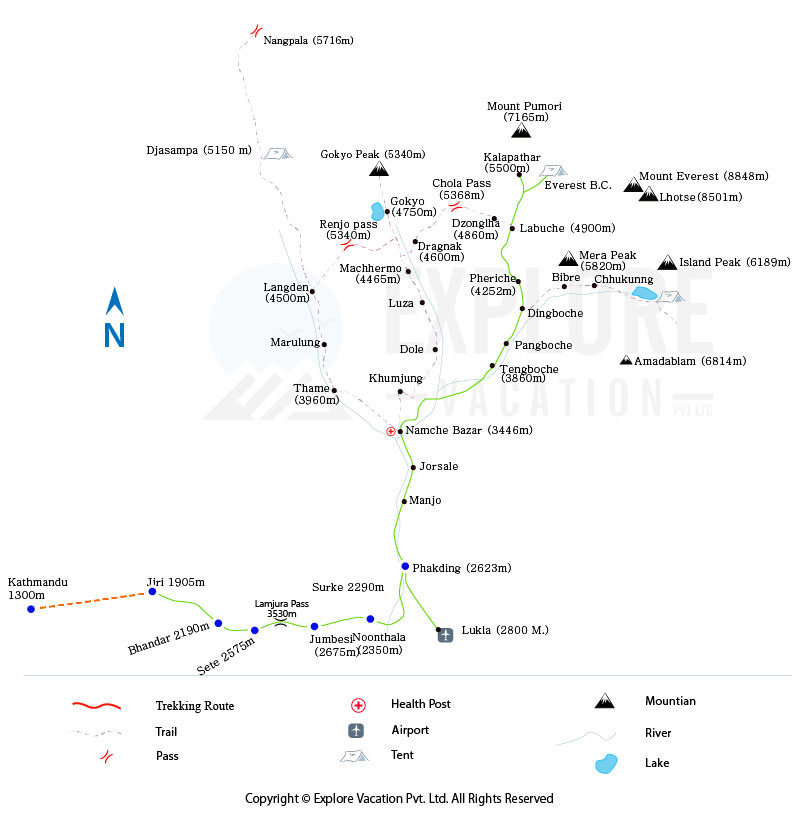
FAQS
Lorem Ipsum is simply dummy text of the printing and typesetting industry. Lorem Ipsum has been the industry’s standard dummy text ever since the 1500s, when an unknown printer took a galley of type and scrambled it to make a type specimen book. It has survived not only five centuries, but also the leap into electronic typesetting, remaining essentially unchanged. It was popularised in the 1960s with the release of Letraset sheets containing Lorem Ipsum passages, and more recently with desktop publishing software like Aldus PageMaker including versions of Lorem Ipsum.
Lorem Ipsum is simply dummy text of the printing and typesetting industry. Lorem Ipsum has been the industry’s standard dummy text ever since the 1500s, when an unknown printer took a galley of type and scrambled it to make a type specimen book. It has survived not only five centuries, but also the leap into electronic typesetting, remaining essentially unchanged. It was popularised in the 1960s with the release of Letraset sheets containing Lorem Ipsum passages, and more recently with desktop publishing software like Aldus PageMaker including versions of Lorem Ipsum.
Traveler Reviews
These full and frank reviews are from travelers who have traveled with Ace the Himalaya previously. The reviews and experiences shown here are from reputable travel websites like TripAdvisor, Google, Facebook, and Trust Pilot, etc.

